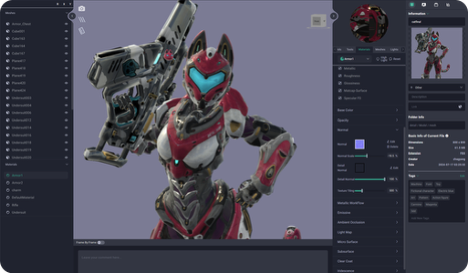From Bottlenecks to Breakthroughs: Rethinking 3D Asset Management in the Cloud
How AI and Cloud-Based 3D Technology Are Transforming Creative Team Productivity
When Workflows Delay Delivery—and Hurt the Bottom Line
Case in Point:
A publicly listed gaming company recently outsourced a set of character designs. The vendor submitted files in FBX format—standard for the industry. However, the internal art team was unable to preview the files directly.
In response, designers rushed to install Maya, only to face version incompatibility. The result: two full weeks lost to file transfers, software debugging, and communication delays. This seemingly small inefficiency created downstream impacts, contributing to missed milestones and fluctuations in the company’s stock price.
The Bigger Challenge: 3D File Bottlenecks Are Costing Companies
According to recent industry data:
73% of creative teams report friction in 3D file collaboration
1.5 hours of productivity are lost per team member, per day
During peak project periods, team stress and turnover risk increase by 200%
These inefficiencies are not just operational—they’re strategic liabilities.
A Strategic Solution: AI-Powered 3D Asset Management
Blueberry AI, a leading innovator in AI-enhanced design workflow tools, is helping enterprise teams overcome these bottlenecks with two core technologies:
1. AI-Powered Semantic Search
Creative professionals no longer need to memorize folder paths or asset codes. With Blueberry AI:
Teams can search for 3D models, textures, and design documentation using natural language input
The system delivers cross-type results in seconds—integrating models, reference files, and annotations
Compared to legacy systems like Perforce, Blueberry AI enables human-readable input and cross-asset discovery
2. Browser-Based 3D File Preview and Annotation
Traditionally, reviewing 3D files requires locally installed software—often with complex licensing and compatibility issues. Blueberry AI eliminates this friction:
| Capability | Legacy Tools | Blueberry AI Platform |
|---|---|---|
| 3D Model Preview | Requires local software | Web-based, instant-loading viewer |
| Visual Feedback & Markup | Not supported | Real-time in-browser annotation |
| Collaboration | Manual file sharing | Live sync with internal and external teams |
Use Case:
A creative director uses a tablet to rotate a 3D model, annotate specific problem areas, and relay feedback to an outsourced team—all within a single browser session.
3D File Preview and Annotation
Tangible Business Outcomes
Organizations that have adopted Blueberry AI report:
82% reduction in annual software-related overhead
30+ hours/month reclaimed per team member
Significant improvements in feedback cycles, delivery speed, and team morale
| Tooling Comparison | Annual Cost (20-member team) |
|---|---|
| Perforce + Unity | $41,760/year ($696 + $1,392 per user) |
| Blueberry AI (All-in-One) | Starting at $7,176/year |
Note: Pricing is based on standard licensing rates and is subject to change.
Why This Matters—Now More Than Ever
Summer marks the highest churn period for design teams. File mismanagement, communication delays, and repetitive work often compound, putting upcoming product launches and Q4 deliverables at risk.
Without a modernized, AI-enhanced 3D workflow, companies risk costly project delays, employee burnout, and operational inefficiency.
“Integrating Blueberry AI allowed our teams to stay aligned and responsive—without the usual delays and miscommunication that plague remote production. For us, it was not just a tool upgrade; it was a competitive advantage.”
— CTO, Publicly Listed Gaming Company
The Path Forward
For C-suite leaders overseeing creative or technical operations, investing in an AI-augmented design infrastructure is no longer optional—it is essential for speed, scale, and resilience.
To explore how to elevate your creative pipeline, visit Blueberry AI or request a personalized demo today.




